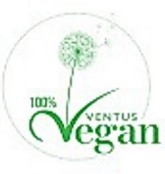Is it worth investing in weak brands? – Vegan
The case: ‘It does make sense to invest in a weak trade mark. Such trade marks are often registered and then benefit from protection. And there are so many of these around.’ Many companies think along these lines. But is it really worth investing in a weak brand? The following case provides some insight:
IMEL, a Greek manufacturer and wholesaler of beauty products, applied for the following Union trade mark for its natural cosmetics and vegan toiletries:

This was opposed by the British cosmetics manufacturer The Vegan Society Corp. lnc. on the basis of its EU trade mark, also registered (in black-and-white) for cosmetic products and used in green:

Was The Vegan Society able to defend its trade mark?
The likelihood of confusion between marks depends largely on the extent of the protection of the earlier mark. This is measured by the degree of distinctiveness: if the earlier mark is highly capable of distinguishing a company’s products on the market, it has a wide extent of protection. If not, the extent of the protection is very limited.
Extent of the protection of the earlier mark
So what was the extent of the protection of the Vegan Society’s trade mark? To ascertain this, we need to look at the trade mark in more detail.
- The first thing that stands out about the mark is the prominent use of the word ‘vegan’. However, this word simply describes the registered cosmetic products as vegan. It is therefore not distinctive and cannot contribute significantly to the protection of the mark as a whole.
- In addition, the mark contains the representation of a sunflower. This image does not directly describe the vegan characteristics of the products. It merely alludes to their vegan nature, which is why it is distinctive. However, the descriptive reference to the sunflower is relatively clear in the context of the mark. Thus, the sunflower in the mark can only refer to the commercial origin of the cosmetics to a limited extent. Nevertheless, it gives the mark a small extent of protection.
- The rest of the design of the ‘V’, with the leaves growing out of it, as well as the circle and the font, are within the realm of common graphic embellishments. They are merely ornamental. They cannot therefore contribute significantly to the extent of the protection of the mark.
- Finally, the green colour used for the mark is not a characteristic of the black-and-white mark. Such a mark is registered as a colourless mark.
Consequently, the Vegan Society’s trade mark could only distinguish the Vegan Society’s cosmetic products on the market to a very limited extent, giving it only an equally limited extent of protection. Since its two components, namely the word ‘vegan’ and the image of a plant, could be understood as a description of the goods, the Office considered that it had only a very limited extent of protection.
Similarity of the marks
Was this extent of the protection sufficient to fend off the later sign? After all, the signs were almost identical at first sight:

This similarity becomes even clearer when the green shape used is contrasted with the earlier mark. And it must be remembered that the public will have only a vague recollection of the marks:

Therefore let’s take a closer look at whether the marks have any relevant similarities.
Similarities between trade marks, for the purposes of the likelihood of confusion and the public’s recollection of them, is determined according to the impression given by the trade marks on the basis of their original visual, aural and conceptual features. If those features are capable, to a large extent, of identifying the goods or services covered by the mark as originating from a particular undertaking and of distinguishing those goods or services from those of other undertakings, they will be easily remembered by the public. Similarity of such features results in the marks being considered similar for the purposes of the likelihood of confusion.
How does the above apply to this case?
- While the marks did share the dominant word ‘vegan’, this word had no distinctive character in either of the marks; it was a straightforward description of the products. The public could not therefore use it to distinguish the products; the similarity between the two ‘vegan’ words resulted at most in a minimal phonetic and conceptual similarity.
- The elements ‘100%’ and the distinctive word ‘Ventus’ will be minimally perceived in the IMEL mark. They are not capable of distinguishing the marks to a significant extent.
- The graphic representation, of the green dandelion flower with the leaves in a ‘V’, together with the stem, is similar to the graphic representation of the sunflower in the earlier mark. It also only alluded to the vegan nature of the products. However, this indirect descriptive reference to the characteristics of the products was clearly discernible. The similarity of the representations of the plants therefore gave rise to only a low degree of visual and conceptual similarity.
- IMEL had also adopted the green colour that the Vegan Society used for its trade mark. However, the green colour was not a feature of the earlier mark, which had been registered in black-and-white. Such a registration does not claim any colour for the mark and is therefore considered to be colourless. Since the green colour of the IMEL mark directly indicated the vegan nature of the cosmetics, it was not distinctive and could not distinguish the marks.
As a result, the marks were only similar in terms of their descriptive and/or weak elements. They were only minimal similarities in terms of their visual, phonetical and conceptual elements.
Likelihood of confusion
Was the (low) degree of similarity between the marks sufficient that they were likely to be confused?
No. The low degree of similarity did not establish a likelihood of confusion, given the limited extent of the protection of the earlier mark, despite the identical goods. Consequently, the Vegan Society’s trade mark had only a limited extent of protection, which was not enough to enable it to succeed in this case.
The EUIPO therefore rejected the opposition based on the earlier mark. The investment in a weak trade mark had not paid off. Whether this decision will be reviewed in the next instance will be interesting to see,
EUIPO, 22 September 2023, B 3174 529.
Learnings: A company can use a mark with descriptive elements and therefore with low distinctiveness in the market. However, it must then accept that competitors are equally entitled to use marks with similar or identical descriptive elements. The extent of the protection of signs with a low degree of distinctiveness is very limited. Therefore, high standards are set in terms of establishing a likelihood of confusion based on the similarity of conflicting signs. In such a case, any investment in a weak mark will usually be lost.